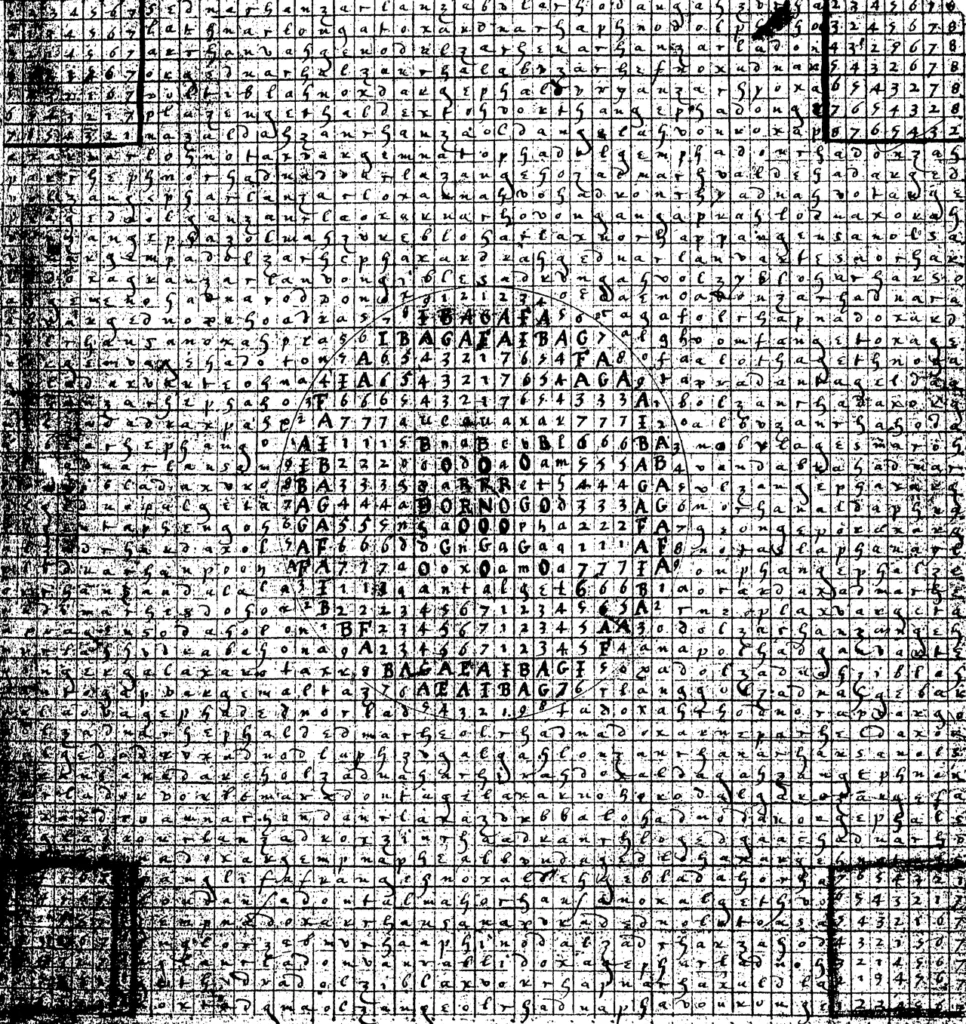Throughout history, cryptic codes and undeciphered texts have puzzled experts, hiding lost knowledge or secrets. Some remain unbroken despite decades of study, fueling speculation and mystery. From ancient inscriptions to modern ciphers, these 22 unsolved puzzles continue to challenge linguists, historians, and codebreakers, leaving their true meanings hidden in time.
22. The Voynich Manuscript (1404-1438)

Discovered in the early 20th century, this 15th-century book is written in an unknown script with bizarre illustrations of plants, astronomical diagrams, and nude figures. Despite intense cryptographic analysis, no one has deciphered its language or meaning, leading to speculation about its origins, purpose, and possible hoax status.
21. The Kryptos Sculpture (1990)

Located at CIA headquarters, this cryptographic sculpture by artist Jim Sanborn contains four encrypted messages. Three have been solved, but the fourth, known as “K4,” remains a mystery despite decades of effort by top codebreakers and cryptographers. Even the artist has hinted at clues, but no full solution exists.
20. The Beale Ciphers (1885)

A set of three coded texts allegedly revealed the location of a vast buried treasure in Virginia. Only one has been deciphered, providing a key, but the other two remain unsolved. Treasure hunters and cryptanalysts alike have been baffled for over a century, with no confirmed treasure discovery.
19. The Zodiac Killer Ciphers (1969-1974)

The infamous serial killer sent multiple encrypted messages to newspapers in the late 1960s. While the first was cracked, several remain unsolved, including a message suspected to reveal his identity. Despite years of investigation, law enforcement and amateur codebreakers have yet to decipher them, leaving the mystery open.
18. The Rohonc Codex (Before 1838)

This mysterious manuscript, discovered in Hungary, contains over 400 pages of undeciphered symbols. Its illustrations suggest religious themes, but the language remains unknown. Some believe it is an elaborate hoax, while others argue it holds the secrets of an ancient, forgotten culture. No definitive translation has been achieved to date.
17. Linear A (1800-1450 BCE)

Linear A is an undeciphered script used by the Minoan civilization around 1800-1450 BCE. Unlike Linear B, which was cracked and linked to Mycenaean Greek, Linear A remains an enigma. Scholars suspect it represents an unknown language, but no one has successfully translated it. Its meaning remains a mystery after many efforts.
16. The Phaistos Disc (Circa 1700 BCE)

The Phaistos Disc is a 3,700-year-old clay disc from Crete, imprinted with mysterious symbols spiraling inward. Despite numerous attempts at translation, its meaning is unclear. Some suggest it represents an unknown language, while others believe it could be a game board, a religious text, or even a carefully crafted historical forgery.
15. The Shugborough Inscription (18th Century)

Found on a monument in England, the sequence “D.O.U.O.S.V.A.V.V.M.” has puzzled historians for centuries. Theories range from connections to the Holy Grail to a hidden Masonic message. Despite extensive study, its true meaning remains elusive. Some believe it is an artistic puzzle rather than an actual cryptographic mystery.
14. The Tamam Shud Case Code (1948)

A dead man found on an Australian beach in 1948 carried a scrap of paper reading “Tamam Shud” (Persian for “finished”). A mysterious code in a book linked to the case has never been deciphered, leaving investigators stumped about the man’s identity, potential espionage links, and his mysterious death.
13. The D’Agapeyeff Cipher (1939)

A supposedly simple encryption is included in Alexander D’Agapeyeff’s 1939 book on cryptography. Ironically, no one has been able to crack it. Some speculate he made an error in the encryption process, while others believe it holds a deeper secret than originally intended, making it a lasting enigma.
12. The Indus Valley Script (2600-1900 BCE)

This script is a yet-undeciphered system of symbols found on artifacts from the Indus Valley Civilization. Scholars debate whether it represents a full language or a form of proto-writing. Without a Rosetta Stone-like key, its meaning remains speculative. Some believe it may never be deciphered without additional discoveries or breakthroughs.
11. The Dorabella Cipher (1897)

Check out this cryptic letter written by composer Edward Elgar in 1897, addressed to a friend. The symbols appear in a unique alphabet, and despite many attempts, no one has deciphered the message. Some suspect it was a personal joke, while others believe it holds a deeper, hidden, yet undeciphered meaning.
10. The McCormick Code (1999)

Two encrypted notes found on the body of Ricky McCormick in 1999 remain unsolved. The FBI has sought public assistance in deciphering them, believing they could reveal details about his death. Despite professional and amateur attempts, no solution has been found, and his case remains an open mystery.
9. The Blitz Ciphers (1941)

Encrypted messages warning of upcoming air raids were sent to British authorities in 1941. The sender and the decryption key remain unknown, leaving historians puzzled. Some suspect a wartime double agent, while others think it was an unsolved intelligence report. The truth remains hidden behind layers of encryption.
8. The Glozel Tablets (1924)

Discovered in France in the 1920s, these tablets bear inscriptions in an unknown script. Some scholars believe they are forgeries, while others argue they contain a lost proto-writing system. Their authenticity and meaning remain hotly debated without consensus, adding to the long list of unresolved archaeological mysteries.
7. The Rongorongo Script (Pre-18th Century)

Easter Island’s mysterious glyph system has yet to be fully understood. It may be one of the few independent writing systems ever created, but its meaning remains elusive. Scholars struggle to interpret its possible historical, religious, or astronomical significance without a bilingual key like the Rosetta Stone.
6. The Pigeon Cipher (World War II)

A small piece of paper, containing seemingly random letters, was tied to a bird’s leg, forming an uncrackable code. Historians believe it may have been part of secret military communications, but without the cipher key, its origin, purpose, and sender remain a mystery, lost to history forever.
5. The Book of Soyga (16th Century)

The Book of Soyga is a mysterious 16th-century text on magic and cryptography. Some sections were deciphered, but others remain unsolved, hinting at hidden knowledge. The book was once owned by John Dee, an advisor to Queen Elizabeth I, who believed it contained supernatural secrets. Scholars still debate its true meaning and significance.
4. The Ogham Stones of Ireland (4th-6th Century CE)

Ancient stones inscribed with the Ogham script have held mystery for centuries. While some can be translated, others contain unknown messages that have defied interpretation. Some researchers believe they contain names or land markers, while others suspect they encode forgotten legends or magical texts. Without additional context, some of these inscriptions remain mysterious.
3. The Liber Loagaeth (16th Century)

A mysterious text dictated to John Dee and Edward Kelley, allegedly by angels, is written in an unknown language and believed to contain magical secrets and hidden knowledge. Despite efforts by scholars and occultists, its full meaning remains undeciphered, fueling speculation about its mystical origins and purpose.
2. The B-Code (2006)

A still-unsolved encrypted message was found within the promotional material for Daniel Suarez’s book Daemon. Intended as a challenge for cryptographers, no one has been able to crack it fully. The author has confirmed its legitimacy but refuses to provide hints, keeping the mystery alive for puzzle enthusiasts.
1. The Feynman Ciphers (1987)

Physicist Richard Feynman presented three encrypted texts as a challenge to cryptographers. One was solved quickly, another took years, and the third remains unsolved. Speculation suggests it may be meaningless, but cryptographers continue to debate its nature, adding to Feynman’s reputation as a brilliant and mischievous thinker.

